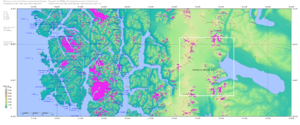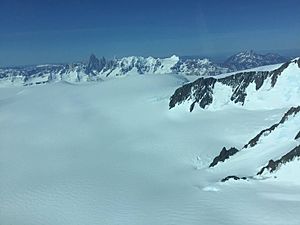Southern Patagonian Ice Field facts for kids
Quick facts for kids Southern Patagonian Ice Field |
|
|---|---|
 |
|
| Type | Ice field |
| Location | Argentina and Chile |
| Coordinates | 49°55′S 73°32′W / 49.917°S 73.533°W |
| Area | 16,800 km2 (6,500 sq mi) |
| Status | Retreating |
The Southern Patagonian Ice Field (Spanish: Hielo Continental or Campo de Hielo Sur), located at the Southern Patagonic Andes between Chile and Argentina, is the world's second largest contiguous extrapolar ice field. It is the bigger of two remnant parts of the Patagonian Ice Sheet, which covered all of southern Chile during the last glacial period, locally called the Llanquihue glaciation.
Contents
Geography
The Southern Patagonia Ice Field extends from parallels 48° 15′ S to 51° 30′ S for approximately 350 kilometres (220 mi), and has an approximate area of 16,480 km2 (6,360 sq mi), of which 14,200 km2 belong to Chile and 2,600 km2 belong to Argentina.
The ice mass feeds dozens of glaciers in the area, among which are the Upsala (765 km2), Viedma (978 km2) and Perito Moreno (258 km2) in the Los Glaciares National Park in Argentina, and the Pío XI Glacier or Bruggen Glacier (1,265 km2, the largest in area and longest in the southern hemisphere outside of Antarctica), O'Higgins (820 km2), Grey (270 km2) and Tyndall (331 km2) in Chile. The glaciers going to the west flow into the fjords of the Patagonian channels of the Pacific Ocean; those going to the East flow into the Patagonian lakes Viedma and Argentino, and eventually, through the rivers de la Leona and Santa Cruz, to the Atlantic Ocean.
An important part of the ice field is protected under different national parks, such as the Bernardo O'Higgins and Torres del Paine in Chile, and the aforementioned Los Glaciares in Argentina.
There are two known volcanoes under the ice field; Lautaro and Viedma. Due to their inaccessibility they are among the least researched volcanoes in Chile and Argentina.
History
Exploration
Thorough explorations include the expeditions of Federico Reichert (1913–1914), Alberto de Agostini (1931), and Harold William Tilman and Jorge Quinteros (1955–1956); as well as Eric Shipton (1960–61). The first (North-South) crossing of the field was accomplished in 1998 by Pablo Besser, Mauricio Rojas, José Montt and Rodrigo Fica. Nevertheless, some areas of the field remain largely unexplored
From the air, initial exploration was conducted in 1928–29 by Gunther Plüschow after whom a glacier is named. It was further studied in 1943 by aerial photographs made by the United States Air Force on request of the Chilean government.
Borderline
Fifty kilometers of the Chile–Argentina border, between Mount Fitz Roy and Cerro Murallón, remain undefined on the ice field.
This Southern Patagonian Ice Field section of the border is the last remaining border issue between Chile and Argentina. On 1 August 1991 the governments of Chile and Argentina agreed on a borderline, but the agreement was never ratified by the Argentine legislature. Later, in 1998, both governments agreed that the line would run along the high peaks and watershed (as specified in their 1941 treaty) northward from Cerro Murallón to a point on a line of latitude due west of "Section B" that was specified in the 1998 agreement a few km southwest of Mt. Fitz roy. However, they also agreed that final demarcation and exact location of the line there would wait until completion of a detailed 1:50,000 scale map of the area and further negotiations. To date, this one section remains the final non-concluded boundary section and an occasional irritant in Argentina-Chile relations.
See also
 In Spanish: Campo de hielo patagónico sur para niños
In Spanish: Campo de hielo patagónico sur para niños

- Southern Patagonian Ice Field dispute
- Northern Patagonian Ice Field
- Circo de los Altares
- List of glaciers
- Argentina-Chile relations
- Laguna del Desierto incident
- Beagle conflict
- Puna de Atacama dispute
- Glaciarium (museum)







